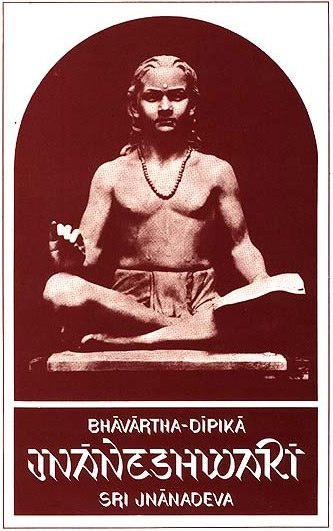Jnaneshwari (Bhavartha Dipika)
by Ramchandra Keshav Bhagwat | 1954 | 284,137 words | ISBN-10: 8185208123 | ISBN-13: 9788185208121
This is verse 4.27 of the Jnaneshwari (Bhavartha-Dipika), the English translation of 13th-century Marathi commentary on the Bhagavad-Gita.—The Dnyaneshwari (Jnaneshwari) brings to light the deeper meaning of the Gita which represents the essence of the Vedic Religion. This is verse 27 of the chapter called Brahma-yajna.
Verse 4.27
Verse 4.27: “Still others offer all the functions of the sense-centres as well as the functions of the Vital Airs into the Fire consisting of the Discipline (Yoga) of concentred meditation on the Self when (the Fire) gets kindled by knowledge. (130)
Commentary called Jnaneshwari by Jnaneshwar:
In this way, O Partha, some become purified and washed off their sins by maintaining sacrificial Fire in the form of Self-control. Some others use the spiritual meditation as an instrument of creating fire, by rubbing on a piece of dry wood in the form of heart, for the purpose of kindling fire (wood). They tied meditation tightly with the rope in the form of their mental firmness and with great sternness pressed it and churned it with the force of the preceptor’s mystic words. With such continued and sustained friction they soon got its fruit in the form of the kindling of the fire of knowledge. But before this Fire of Knowledge got kindled there first issued a little smoke and this was the infatuating lure of magic powers. With the clearing away of smoke, the first spark of the fire of knowledge blazed itself forth. This spark got an inflammable substance in the form of soul dried up and become subtle and fine on account of the control over it, which got kindled and spread out in flames and in this are burnt the sticks of dried wood (samidhā) in the form of multiform desires, along with purified butter in the form of secret longings and passions. The sacrificial priest gave oblations of the acts of the senses in the fire of knowledge accompanied by the recital of the hymn ‘I am the Brahman.’ The last oblation in the form of activities of the Vital Airs is then given into the Fire together with the hay-spoon (sruvā) and then took place the final sacred spiritual bath (avabhṛtha) following the conclusion of the sacrifice, in the emergence of the state of merging off in the Brahman. After this, they took out the residues left of oblations at the completion of the sacrifice of Self-control in the form of their realisation of the highest self-vision. Not a few secured emancipation through such sacrifices. Although the various kinds of sacrifices so far mentioned appear different from each other, still the result of all, is one and the same viz. getting (one with) the Supreme Brahman.
